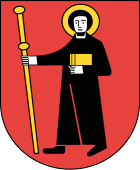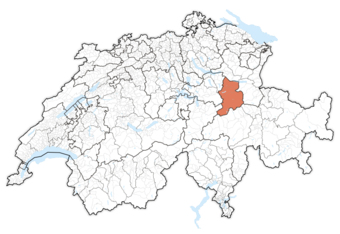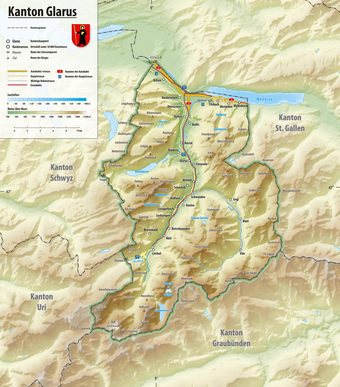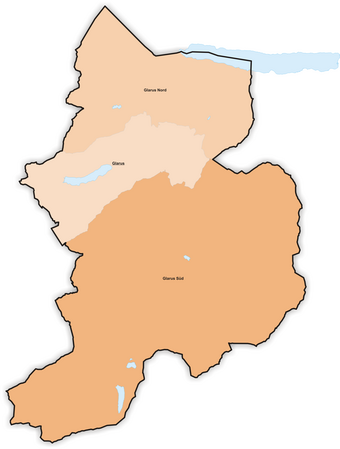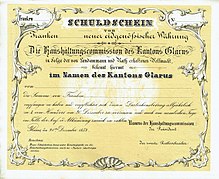Canton of Glarus
| Canton of Glarus | |
|---|---|
| coat of arms | |
| Canton of the Swiss Confederation | |
| Abbreviation / license plate : | GL |
| Official language : | German |
| Main town : | Glarus |
| Largest place : |
Glarus North (population) Glarus South (area) |
| Accession to the federal government : | 1352 |
| Area : | 685.31 km² |
| Height range : | 411–3610 m above sea level M. |
| Website: | www.gl.ch |
| population | |
| Resident: | 40,590 (December 31, 2019) |
| Population density : | 59 inhabitants per km² |
|
Proportion of foreigners : (residents without citizenship ) |
24.2% (December 31, 2019) |
| Unemployment rate : | 1.8% (June 30, 2021) |
| Location of the canton in Switzerland | |
| Map of the canton | |
| Political municipalities of the canton | |
Coordinates: 47 ° 0 ' N , 9 ° 3' E ; CH1903: seven hundred and twenty-two thousand five hundred forty-seven / 206696
Glarus ( abbreviation GL ; Swiss German Glaris, French Glaris, Italian Glarona, Rhaeto-Romanic ) is a canton in German-speaking Switzerland and is one of the regions of northeast and southeastern Switzerland . The main town is the town of the same name, Glarus , the most populous town is the municipality of Glarus Nord .
geography

The canton comprises the catchment area of the Linth to the Walensee and the Linth plain west of the Linth to Bilten and the Kerenzerberg . The Glarnerland is characterized by large differences in altitude: from the flat valley floor at an altitude of 414 meters, the terrain rises to over 3600 meters ( Tödi , 3614 m above sea level ). These contrasts are reflected in the climate: within a few kilometers it changes from mild on Lake Walen with its southern flora to high alpine on the glaciated mountain peaks; and when the foehn blows through the valley, temperature records can be measured. The valley is only open to the north to the Lin plateau.
The 685 square kilometer canton roughly corresponds to the catchment area of the Linth. The Sernf or Kleintal is the only side valley that offers space for village settlements. The Klöntal , the most important western tributary valley, is, as Carl Spitteler praises, with its mountain lake “as beautiful as no dream would guess”.
The most visible human intervention to tame nature is the imposing Linth work , which shapes the face of the entire region. The Linth correction was started in 1807 as Switzerland's first national work . The Linth is directed into the Walensee and its course is channeled into the Zurich Lake . Before that, it flowed slowly back to Lake Zurich, increasingly damming the outflow from the Walensee and swamping the Lint Plain.
population
resident
As of December 31, 2019, the population of the canton of Glarus was 40,590. The population density of 59 inhabitants per square kilometer is below the Swiss average (208 inhabitants per square kilometer). The proportion of foreigners (registered residents without Swiss citizenship ) was 24.2 percent on December 31, 2019, while 25.3 percent were registered nationwide. As of June 30, 2021, the unemployment rate was 1.8 percent compared to 2.8 percent at the federal level.
languages
The official language in the canton of Glarus is German . 83.6 percent of the population are German and 6.8 percent Italian .
The Glarus dialect is not uniform, but what the Glarus idioms have in common is the melodious, singing language. Glarus German is one of the dialects of Höchst Alemannic .
Religions - denominations
The federal census from 2000 revealed the following denomination picture:
- 44.0% Protestant (the Federal Statistical Office also includes Jehovah's Witnesses and the New Apostolic religious community)
- 37.3% Roman Catholic
- 2.3% Christian Orthodox
- 6.5% Muslim
- 3.5% other denominations or no information
- 6.5% non-denominational
The Evangelical Reformed Church of the Canton of Glarus and the Roman Catholic Church are state-recognized corporations under public law. The two churches organize their internal affairs independently and issue a constitution that requires the approval of the district administrator.
Constitution and Politics

The current constitution of the Canton of Glarus was adopted by the Landsgemeinde on May 1st, 1988 and has been revised several times since then.
legislative branch
Landsgemeinde
The Landsgemeinde is the assembly of residents who are entitled to vote and thus the highest body of the canton. The ordinary Landsgemeinde takes place every year on the first Sunday in May and is led by the Landammann . The basis for the negotiations are the submissions of the district administrator (parliament) published in the memorial or in the official gazette; other items may not be advised. Every participant entitled to vote has the right to submit requests for support, amendment, rejection, postponement or rejection of the submissions.
The Landsgemeinde elects the Landammann (President of the Cantonal Government) and the Provincial Governor (Vice-President of the Cantonal Government), the court presidents and the other judges.
It decides on the enactment and amendments to the cantonal constitution and on the enactment, amendment and repeal of cantonal laws. It takes decisions on all one-off expenses of more than 1 million francs and all recurring expenses of more than 200,000 francs per year. It also sets the tax rate.
In contrast to the canton of Appenzell Innerrhoden , the elections for the government council and the council of states do not take place in the rural community, but in a secret ballot at the ballot box.
District Administrator
The district administrator is the canton's parliament. It has sixty members who are elected by the people at the ballot box in three constituencies (corresponding to the three municipalities) in the proportional representation system for four years each. Every year the district administrator elects the president, the vice-president and the other members of the district administration office from among its members.
He is the supreme supervisory authority over the government, the administration and the courts. He advises the constitution and legislation and the other resolutions for the attention of the Landsgemeinde and issues ordinances, administrative and financial resolutions on his own authority. It also decides on basic or generally binding planning.
The last district elections took place on June 10, 2018 and resulted in the following distribution of seats:
| Parties in the district administrator (seats) | 2014 | 2018 | Distribution of seats | Share of voters in percent |
|---|---|---|---|---|
| Swiss People's Party (SVP) | 17th | 16 | ||
| Free Democratic Party (FDP) | 12th | 11 | ||
| Bourgeois Democratic Party (BDP) | 9 | 8th | ||
| Social Democratic Party of Switzerland (SP) | 7th | 8th | ||
| Green Party of Switzerland (GPS) | 7th | 7th | ||
| Christian Democratic People's Party (CVP) | 6th | 6th | ||
| Green Liberal Party (glp) | 2 | 4th |
executive
The government council is the government of the canton. Since 2006, it has consisted of five (previously seven) members who are elected by the people at the ballot box in a single constituency in the majority voting system for four years each. Its President ( Landammann ) and Vice President (State Governor) are each elected by the Landsgemeinde for two years.
It is the leading and supreme executive authority, plans state action, represents the canton externally and leads the cantonal administration. He drafts the laws and legislative ordinances for the attention of the District Administrator and the Landsgemeinde and issues executive and administrative ordinances on his own authority.
Since the elections on March 4, 2018, the government council has been composed as follows:
| Government Council | Political party | department |
|---|---|---|
| Andrea Bettiga , Landammann | FDP | Security and Justice Department |
| Rolf Widmer | CVP | Finance and Health Department |
| Benjamin Mühlemann | FDP | Department of Education and Culture |
| Kaspar Becker | BDP | Department of Construction and Environment |
| Marianne Lienhard , Provincial Governor | SVP | Department of Economics and Home Affairs |
Markus Heer ( SP ) was elected in the second ballot on March 28, 2021 in the replacement election for Rolf Widmer, who was stepping down at the end of April 2021 . Inferior to him was Jürg Feldmann (CVP / Die Mitte).
Judiciary
The first judicial instance is the cantonal court , which is divided into two civil chambers, a criminal chamber and a criminal court commission. The second judicial instance is the higher court .
The canton of Glarus has a cantonal arbitration authority that has the task of bringing about an amicable settlement between the parties in civil law disputes prior to legal proceedings. Introduced by the Landsgemeinde resolution of 2017, it replaced one cantonal arbitration authority each for tenancies and equality, and three communal mediation offices.
The administrative jurisdiction is exercised by the Administrative Court. In addition, there are administrative-independent appeals committees for special administrative disputes.
The judges are elected by the Landsgemeinde for a four-year term. The prosecution is carried out by the public prosecutor's office and the youth prosecutor's office.
Political communities
With the Landsgemeinde resolution of May 7th, 2006, the local parishes of Glarus, school parishes , welfare parishes and Tagwen (civil parishes ) were amalgamated on January 1st, 2011 (see Glarner parish reform ), so that only three parishes have existed since then . This resolution was clearly confirmed on November 25, 2007 in an extraordinary rural community.
|
|
In addition to these three unified congregations, there are also the parishes of the Evangelical Reformed Regional Church of the Canton of Glarus and the Roman Catholic Church, which are also recognized under public law .
The canton of Glarus has no division into districts. However, the Federal Statistical Office (FSO) lists the entire canton as one district under FSO no. : 0800.
Voting age 16
With the state community resolution of May 6, 2007, the voting age was set at 16. In a hard-fought debate and with a tight result, the JUSO Glarus proposal prevailed. Since then, in the canton of Glarus - as the first and so far only Swiss canton - citizens aged 16 and over have been able to exercise the right to vote and be elected in cantonal matters. The right to stand as a candidate remains at 18 years of age.
Representation in the Federal Assembly
The canton of Glarus sends one representative to the National Council and two to the Council of States . The current National Councilor of Glarus is Martin Landolt ( BDP ), the members of the Glarus Council of States are Thomas Hefti ( FDP , since 2014) and Mathias Zopfi ( Greens , since 2019). For the two representatives in the Council of States, the right to stand as candidates is restricted insofar as they cannot be re-elected once they have reached the age of 65.
Infrastructure and economy

traffic
Most of the Glarus region is served by the Rapperswil SG –Glarus – Schwanden and Zurich – Ziegelbrücke –Linthal railway lines. The hourly regional trains also serve Ziegelbrücke, the most important transport hub in the area. Since the timetable change on December 14, 2014, the S25 of the Zurich S-Bahn connects Glarus and Zurich every hour without changing in 58 minutes. A progress that the commuter club fought for for several years. The concessionaires for bus transport are the Swiss Federal Railways , the Swiss Postbus Service and, in the hinterland, the Autobetrieb Sernftal (AS) as the successor to the Sernftalbahn, which was shut down in 1969 . In 2019, the degree of motorization (passenger cars per 1000 inhabitants) was 588.
Agriculture and industry
In agriculture , livestock and especially dairy farming predominate . In 2020, 32 percent of the canton's agricultural area was organically farmed by 97 farms . The main branch of the economy, however, is industry, especially the textile industry , machine and apparatus construction , wood processing and the building materials industry . The canton of Glarus was one of the first and most industrialized areas in Switzerland. In addition, electricity generation through hydropower plants and tourism are important.
tourism

Tourism is of great importance - especially in the towns of Braunwald , Elm and Filzbach - the service sector is growing steadily and the infrastructure in the valley is very well developed.
The Glarner Industrieweg leads in several stages to the most important stations in Glarus industrial history.
School and culture
The school system in the canton of Glarus is well developed: Kindergarten, elementary school (partly introductory classes , special and auxiliary schools) with upper, secondary and secondary schools ; There is also the working year, the voluntary tenth school year, the annual housekeeping course and the integration class.
At the district school Glarus can Swiss maturity attained and the secondary school attended. There are also adult education courses.
In Ziegelbrücke there is a vocational school, in Glarus the one for commercial professions and the nursing school. Around 130 professions can be learned in around 400 training companies in the canton.
The rich offerings from the State Archives and, above all, the modern Glarus State Library serve not only those who are hungry for education, but also those interested in history and culture or simply enjoy reading, listening and viewing. With the map collection by Walter Blumer and the cartography library by Arthur Dürst, the state library (canton library) has little-known but historically interesting research material .
Glarus has a renowned art house built as such. The Tschudi Gallery in Glarus and various private galleries also repeatedly show sights from the field of performing arts, which are practiced by numerous artists in the canton.
The Braunwald Music Week is the most traditional event of this type in all of Europe. It not only invites the participants to listen, but also to actively participate. The Glarus Music School, together with numerous associations and groups, contributes to musical life. And the Modern Music School - Glarnerland complements the traditional training offer with a program specializing in modern styles.
The Glarner Konzert and Theatergesellschaft as well as the Holenstein Glarus Culture and Association Center (especially in alternative culture) are also active.
In terms of sport, there is an offer in various sports centers and of course the nearby mountains and lakes attract local activity. The first Swiss Alpine Club hut in Switzerland, the Grünhornhütte , was built in the canton of Glarus, on the Tödi , and the cradle of Swiss skiing was in the Glarnerland.
story
coat of arms
The Glarus coat of arms is the only cantonal coat of arms in Switzerland to show a person: Saint Fridolin with a walking stick and Bible. According to legend, Fridolin was an Irish messenger of faith who lived at the beginning of the 6th century and through whose influence the inhabitants of the Glarus region became Christians . In church representations he is accompanied by a skeleton.
The legend reports that Fridolin, who was given large parts of the Glarnerland by the dying, rich Ursus, took him out of the grave for help in an inheritance dispute with his brother Landolf. When Landolf saw his brother, who had already decayed, appear in court, he was so shocked and ashamed that he also gave Fridolin his part of the Glarnerland. In this way, the affiliation of the Glarnerland to the Säckingen monastery in Germany, founded by Fridolin, was declared, and Fridolin is considered the patron saint of inheritance sneaking.
literature
- Fridolin Baumgartner, Fridolin Walcher (photos): Glarner Heimatbuch. Published by the Department of Education and Culture of the Canton of Glarus. Lehrmittelverlag des Kantons Glarus, Glarus 2008, ISBN 978-3-85546-188-2 (online version: Glarner Heimatbuch , accessed on August 10, 2010).
- Hans Laupper: Glarus (Canton). In: Historical Lexicon of Switzerland .
- Josef Schwitter, Urs Heer (photos): The Glarnerland. A brief portrait. Baeschlin, Glarus 2000 (first edition 1996), ISBN 3-85546-112-0 .
Web links
|
Further content in the sister projects of Wikipedia:
|
||
|
|
Commons | - Media content (category) |
|
|
Wiktionary | - Dictionary entries |
|
|
Wikinews | - News |
|
|
Wikisource | - Sources and full texts |
|
|
Wikivoyage | - Travel Guide |
- Official website of the Canton of Glarus
- Official statistics
- Link catalog on the subject of the Canton of Glarus at curlie.org (formerly DMOZ )
Individual evidence
- ^ Structure of the permanent resident population by canton, 1999–2019. In: bfs. admin.ch . Federal Statistical Office (FSO), August 27, 2020, accessed on February 28, 2021 .
- ^ Structure of the permanent resident population by canton, 1999–2019. In: bfs. admin.ch . Federal Statistical Office (FSO), August 27, 2020, accessed on February 28, 2021 .
- ↑ Unemployment figures . In: seco. admin.ch . State Secretariat for Economic Affairs (SECO), July 8, 2021, accessed on July 12, 2021 (see publication “The situation on the labor market in June 2021” of July 8, 2021).
- ^ Structure of the permanent resident population by canton, 1999–2019. In: bfs. admin.ch . Federal Statistical Office (FSO), August 27, 2020, accessed on February 28, 2021 .
- ^ Structure of the permanent resident population by canton, 1999–2019. In: bfs. admin.ch . Federal Statistical Office (FSO), August 27, 2020, accessed on February 28, 2021 .
- ↑ Unemployment figures . In: seco. admin.ch . State Secretariat for Economic Affairs (SECO), July 8, 2021, accessed on July 12, 2021 (see publication “The situation on the labor market in June 2021” of July 8, 2021).
- ↑ Federal Statistical Office - Resident population by religion, by cantons and cities ( Memento of December 29, 2008 in the Internet Archive ). Retrieved June 28, 2019.
- ^ Constitution of the Canton of Glarus of May 1, 1988.
- ↑ Summary of the district elections 2018 ( PDF ; 775 kB ). State Chancellery - Canton of Glarus. Retrieved March 4, 2019.
- ^ Substitute election to the government council: Markus Heer elected to the government council. In: gl.ch. March 28, 2021, accessed March 28, 2021 .
- ↑ Kurt Nuspliger : Bernese constitutional law and basic features of the constitutional law of the cantons . Stämpfli AG , Bern 2008, ISBN 3-7272-1533-X , p. 29 f .
- ↑ Art. 78 Constitution of the Canton of Glarus
- ↑ SBB online timetable
- ↑ bfs.admin.ch
- ↑ Biological Agriculture, 2020. In: atlas.bfs.admin.ch. Federal Statistical Office , accessed on May 11, 2021 .
